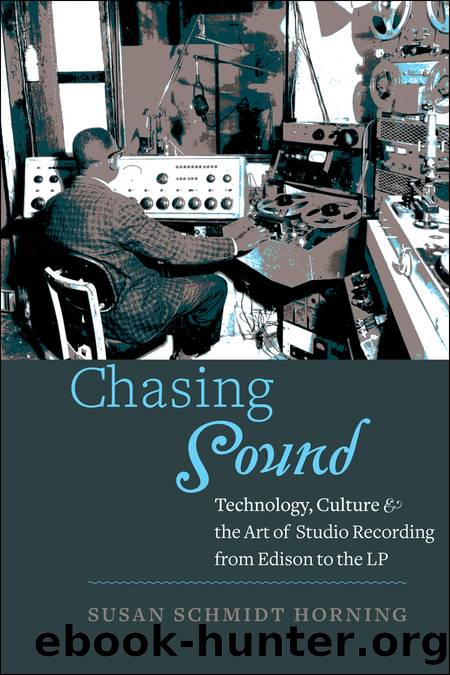Chasing Sound: Technology, Culture, and the Art of Studio Recording From Edison to the LP by Susan Schmidt Horning

Author:Susan Schmidt Horning [Horning, Susan Schmidt]
Language: eng
Format: epub
Tags: history, United States, General, Americas (North; Central; South; West Indies), music, History & Criticism, Recording & Reproduction, science
ISBN: 9781421410227
Google: TSCcAQAAQBAJ
Publisher: JHU Press
Published: 2013-12-15T23:57:54.615262+00:00
âHum Your Tune. Hits Start at Schneider Recordingâ
The forty-year history of another Cleveland studio, Schneider Recording, offers a view into a different kind of independent studio that flourished in the postwar period. Although Hank Schneider began recording polka musicians and advertising clients, just as Fred Wolf had in the 1930s, Schneider Recording remained a small, family-owned and operated business, offering a range of services in addition to recording. Hank Schneider was an engineer as well as a musician, but his studio never became as technologically advanced as Cleveland Recording. From the time he opened the studio in 1945 until his death in 1984, Hank Schneider and his wife, Kay, served a wide range of clients, from advertising agencies and corporations to professional musicians and amateur songwriters. They maintained a conservative approach to running the studio, never investing in more equipment than the business would support. By keeping it small and personalized, they weathered business fluctuations that put many other small studios out of business. Schneider Recording Studio Laboratory, as it was called in the early years, could indeed boast that it recorded the original audition records for several hit songs of the 1950s, as well as album masters for companies such as Decca and RCA Victor.52 Precisely because its doors were open to even those who had done no more than sing in the shower, Schneider provided an invaluable service to songwriting hopefuls who otherwise would never have entered a recording studio. Kay Schneider recounted that just about every songwriter who came through Schneiderâs door would say something like, âNow I wouldnât even be here if my tune wasnât better than âStardust.â â53 Whether it was or not did not matter to the Schneiders. Their interest was in providing a service, not in profiting from the songs they recorded, or in promising to place songs with artists, as did the âsong sharksâ of Tin Pan Alley.54
Hank Schneider possessed a unique background that combined technical training and professional musicianship that ideally suited him for the newly emerging audio engineering field. As a young boy, he built crystal radio sets and later opened a radio shop in Oak Park, Illinois. He started his own band at age fifteen, played trombone with Benny Goodman and Gene Krupa in Chicago, and later performed with orchestras on Mississippi riverboats. From the 1920s through the early 1940s, he arranged music for live radio broadcasts, and during World War II, he served with the Army Signal Corps. After years on the road as a touring musician, Schneider and his wife settled in Cleveland at the St. Regis Hotel. Schneider rented a downtown office space, initially as a place to do his musical arranging while he played with local radio orchestras and club bands. Soon he purchased a Presto disc recorder and a Brush crystal microphone, listed as Henry C. Schneider Recording Studio in the telephone directory, and offered his services as lead sheet arranger, musician, and recording engineer. Between that modest advertising and Schneiderâs reputation among local
Download
This site does not store any files on its server. We only index and link to content provided by other sites. Please contact the content providers to delete copyright contents if any and email us, we'll remove relevant links or contents immediately.
Kathy Andrews Collection by Kathy Andrews(11733)
The remains of the day by Kazuo Ishiguro(8828)
Paper Towns by Green John(5092)
Spare by Prince Harry The Duke of Sussex(5074)
Industrial Automation from Scratch: A hands-on guide to using sensors, actuators, PLCs, HMIs, and SCADA to automate industrial processes by Olushola Akande(4987)
The Body: A Guide for Occupants by Bill Bryson(4976)
Machine Learning at Scale with H2O by Gregory Keys | David Whiting(4190)
Be in a Treehouse by Pete Nelson(3952)
Never by Ken Follett(3796)
Harry Potter and the Goblet Of Fire by J.K. Rowling(3775)
Goodbye Paradise(3729)
Into Thin Air by Jon Krakauer(3313)
The Remains of the Day by Kazuo Ishiguro(3295)
The Cellar by Natasha Preston(3263)
The Genius of Japanese Carpentry by Azby Brown(3226)
Fairy Tale by Stephen King(3220)
120 Days of Sodom by Marquis de Sade(3184)
The Man Who Died Twice by Richard Osman(2997)
Drawing Shortcuts: Developing Quick Drawing Skills Using Today's Technology by Leggitt Jim(2996)
